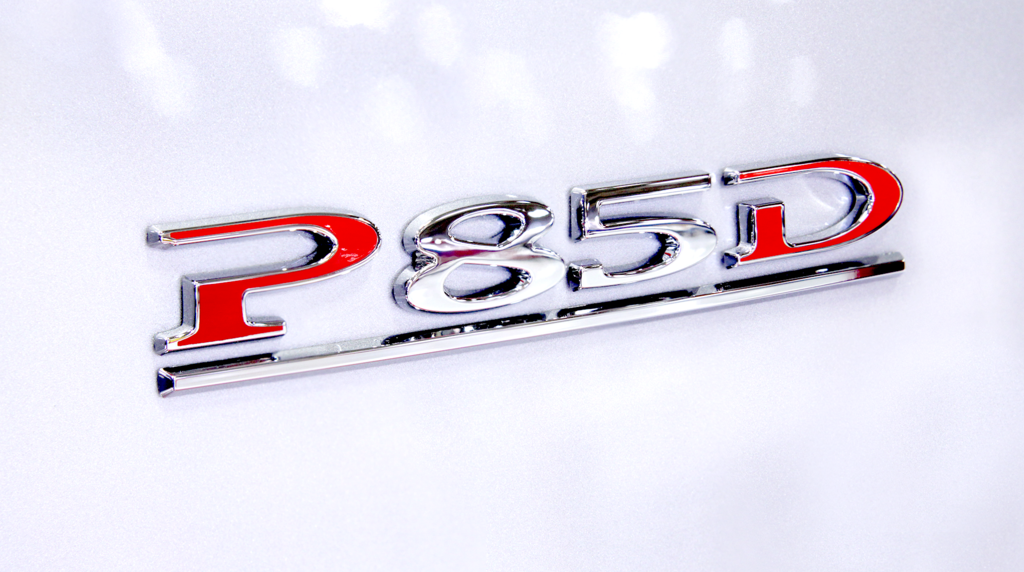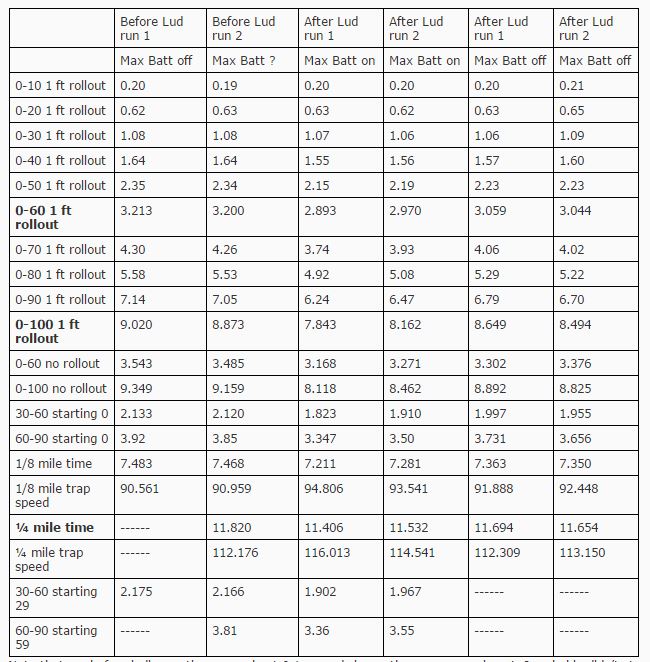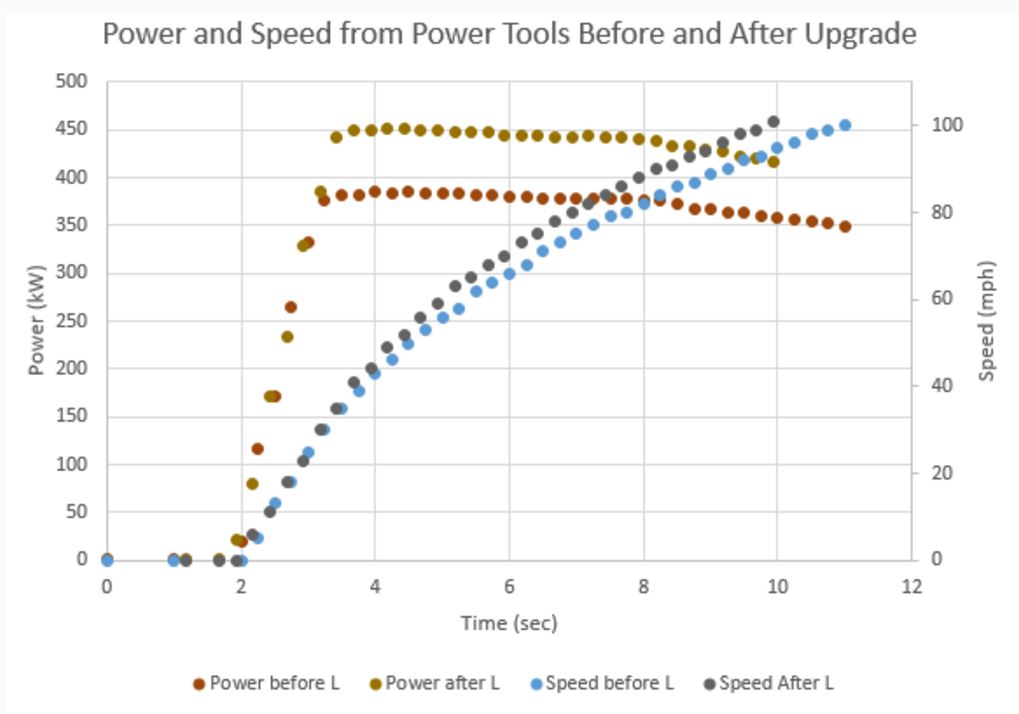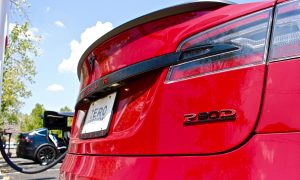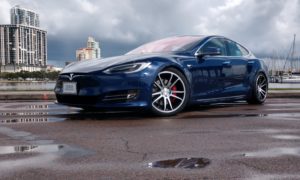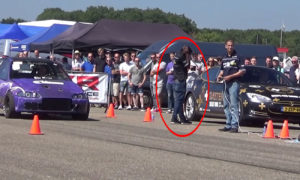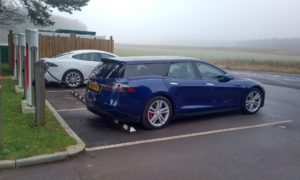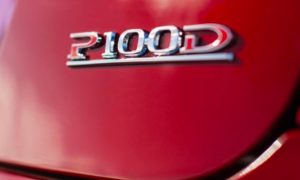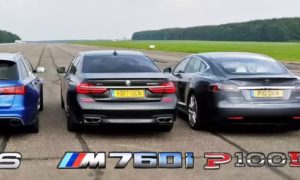News
Performance Gains after P85D Ludicrous Mode Upgrade
TMC member thimel recently had the Ludicrous mode upgrade installed on his Model S P85D. He carefully measured the performance of his car before and after, and found that Ludicrous mode is worth about a half second to 60 mph and a noticeable increase in power at all speeds up to 80.
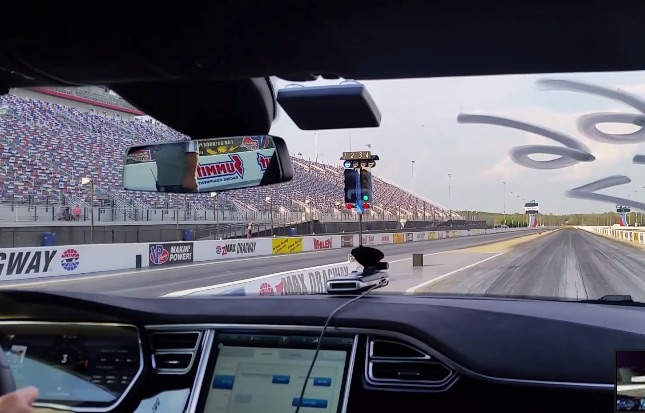
Just how much faster is the the P85D with Ludicrous Mode upgrade? According to Tesla Motors Club (TMC) member thimel, the performance gains are significant, to the tune of 19% more power above 30 mph and a drop in 0-60 time from 3.2 to 2.9 seconds. Quarter mile time also drops from an already quick 11.8 seconds to an astounding 11.5 seconds.
thimel carefully measured the performance of the P85D both before and after the Ludicrous Mode upgrade. The performance data was then meticulously charted and plotted, painting a clear picture of the performance differences from the $5,000 retrofit.
According to thimel’s post from the TMC forum, “I started the before Ludicrous tests early in the morning and had not driven the car for many hours, but had charged it that night. The ambient temperature in my garage that morning was 59 degrees and it was 50 degrees outside during the tests. I started with a 90% charge and by the time I was done the charge was 70%. Creep mode was off to help avoid a very slow start. Insane mode was on of course. Climate control was off.
“I drove a few miles before starting the first test but did nothing else to warm the battery. I drove 5 miles at moderate acceleration and speeds between acceleration passes. This was both to give a chance for things to cool down and to return me to the same starting point for each acceleration pass.data shows the Ludicrous mode upgrade it worth nearly a half second in the sprint to 60 mph and several more miles per hour at the end of the quarter mile. ”
Next he charted his power and speed against time and found power to range from 380 kW, before the Ludicrous upgrade, to 451 kW after the upgrade with the Max Battery Power setting on. The setting heats the Tesla battery to a higher temperature thereby reducing its impedance and increasing current to provide short term acceleration and performance gains.
The biggest boost in performance after the Ludicrous upgrade happens above 30 mph. Below that, performance is about the same. But with Ludicrous mode engaged, there is a sizable increase in available torque. Before the upgrade, lateral acceleration reaches approximately 1.15 g at 15 mph, then falls below 1 g after 25 mph. After the upgrade, lateral acceleration peaks at 1.1 g and continues to pull over 1 g until slightly past 30+ mph. Most notably, the acceleration is consistently above the pre-Ludicrous Mode upgrade all the way until 80 mph.
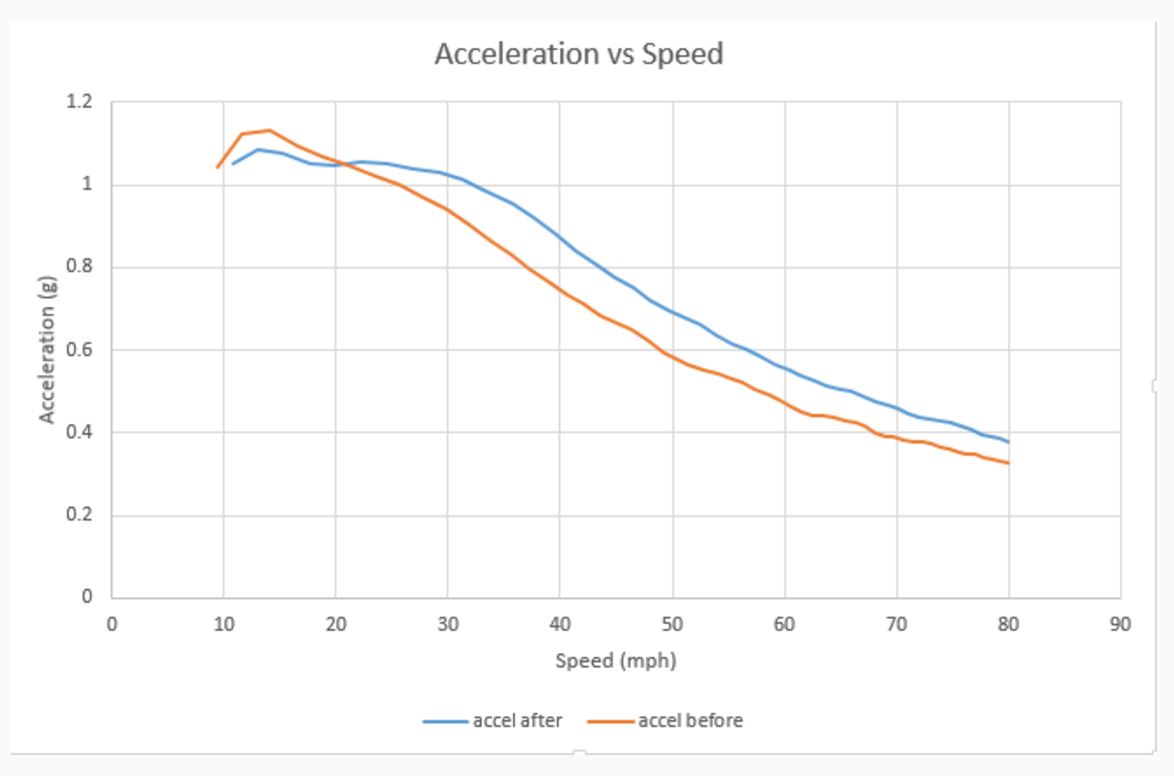
[Image source: thimel via TMC]
In his notes, thimel makes some interesting points. “Above 30 mph, ludicrous clearly has more power. This is seen directly with the PowerTools readout…..which shows the maximum power increased from 380 to 451 kW, a 19% increase and by the shorter times to achieve speeds above 30 mph. The max power measured from the battery was 451 kW. This compares to 458 kW that Pete90D measured on his P90DL. So the battery doesn’t make much of a difference. The 0-60 time I got of 2.89 is also nearly identical to that Pete90D got of 2.901.”
He ends his post with this conclusion: “The P85D with ludicrous upgrade is significantly faster than without. There is 19% more power above 30 mph, 0-60 time drops from 3.2 to 2.9 seconds and the quarter mile time drops from 11.8 to 11.5. So it was fast before and is faster now. You get about two-thirds of the improvement if you don’t heat the battery with max battery power.”
News
Tesla launches in India with Model Y, showing pricing will be biggest challenge
Tesla finally got its Model Y launched in India, but it will surely come at a price for consumers.

Tesla has officially launched in India following years of delays, as it brought its Model Y to the market for the first time on Tuesday.
However, the launch showed that pricing is going to be its biggest challenge. The all-electric Model Y is priced significantly higher than in other major markets in which Tesla operates.
On Tuesday, Tesla’s Model Y went up for sale for 59,89,000 rupees for the Rear-Wheel Drive configuration, while the Long Range Rear-Wheel Drive was priced at 67,89,000.
This equates to $69,686 for the RWD and $78,994 for the Long Range RWD, a substantial markup compared to what these cars sell for in the United States.
🚨 Here’s the difference in price for the Tesla Model Y in the U.S. compared to India.
🚨 59,89,000 is $69,686
🚨 67,89,000 is $78,994 pic.twitter.com/7EUzyWLcED— TESLARATI (@Teslarati) July 15, 2025
Deliveries are currently scheduled for the third quarter, and it will be interesting to see how many units they can sell in the market at this price point.
The price includes tariffs and additional fees that are applied by the Indian government, which has aimed to work with foreign automakers to come to terms on lower duties that increase vehicle cost.
Tesla Model Y seen testing under wraps in India ahead of launch
There is a chance that these duties will be removed, which would create a more stable and affordable pricing model for Tesla in the future. President Trump and Indian Prime Minister Narendra Modi continue to iron out those details.
Maharashtra Chief Minister Devendra Fadnavis said to reporters outside the company’s new outlet in the region (via Reuters):
“In the future, we wish to see R&D and manufacturing done in India, and I am sure at an appropriate stage, Tesla will think about it.”
It appears to be eerily similar to the same “game of chicken” Tesla played with Indian government officials for the past few years. Tesla has always wanted to enter India, but was unable to do so due to these import duties.
India wanted Tesla to commit to building a Gigafactory in the country, but Tesla wanted to test demand first.
It seems this could be that demand test, and the duties are going to have a significant impact on what demand will actually be.
Elon Musk
Tesla ups Robotaxi fare price to another comical figure with service area expansion
Tesla upped its fare price for a Robotaxi ride from $4.20 to, you guessed it, $6.90.

Tesla has upped its fare price for the Robotaxi platform in Austin for the first time since its launch on June 22. The increase came on the same day that Tesla expanded its Service Area for the Robotaxi ride-hailing service, offering rides to a broader portion of the city.
The price is up from $4.20, a figure that many Tesla fans will find amusing, considering CEO Elon Musk has used that number, as well as ’69,’ as a light-hearted attempt at comedy over the past several years.
Musk confirmed yesterday that Tesla would up the price per ride from that $4.20 point to $6.90. Are we really surprised that is what the company decided on, as the expansion of the Service Area also took effect on Monday?
But the price is now a princely $6.90, as foretold in the prophecy 😂
— Elon Musk (@elonmusk) July 14, 2025
The Service Area expansion was also somewhat of a joke too, especially considering the shape of the new region where the driverless service can travel.
I wrote yesterday about how it might be funny, but in reality, it is more of a message to competitors that Tesla can expand in Austin wherever it wants at any time.
Tesla’s Robotaxi expansion wasn’t a joke, it was a warning to competitors
It was only a matter of time before the Robotaxi platform would subject riders to a higher, flat fee for a ride. This is primarily due to two reasons: the size of the access program is increasing, and, more importantly, the service area is expanding in size.
Tesla has already surpassed Waymo in Austin in terms of its service area, which is roughly five square miles larger. Waymo launched driverless rides to the public back in March, while Tesla’s just became available to a small group in June. Tesla has already expanded it, allowing new members to hail a ride from a driverless Model Y nearly every day.
The Robotaxi app is also becoming more robust as Tesla is adding new features with updates. It has already been updated on two occasions, with the most recent improvements being rolled out yesterday.
Tesla updates Robotaxi app with several big changes, including wider service area
News
Tesla Model Y and Model 3 dominate U.S. EV sales despite headwinds
Tesla’s two mainstream vehicles accounted for more than 40% of all EVs sold in the United States in Q2 2025.

Tesla’s Model Y and Model 3 remained the top-selling electric vehicles in the U.S. during Q2 2025, even as the broader EV market dipped 6.3% year-over-year.
The Model Y logged 86,120 units sold, followed by the Model 3 at 48,803. This means that Tesla’s two mainstream vehicles accounted for 43% of all EVs sold in the United States during the second quarter, as per data from Cox Automotive.
Tesla leads amid tax credit uncertainty and a tough first half
Tesla’s performance in Q2 is notable given a series of hurdles earlier in the year. The company temporarily paused Model Y deliveries in Q1 as it transitioned to the production of the new Model Y, and its retail presence was hit by protests and vandalism tied to political backlash against CEO Elon Musk. The fallout carried into Q2, yet Tesla’s two mass-market vehicles still outsold the next eight EVs combined.
Q2 marked just the third-ever YoY decline in quarterly EV sales, totaling 310,839 units. Electric vehicle sales, however, were still up 4.9% from Q1 and reached a record 607,089 units in the first half of 2025. Analysts also expect a surge in Q3 as buyers rush to qualify for federal EV tax credits before they expire on October 1, Cox Automotive noted in a post.
Legacy rivals gain ground, but Tesla holds its commanding lead
General Motors more than doubled its EV volume in the first half of 2025, selling over 78,000 units and boosting its EV market share to 12.9%. Chevrolet became the second-best-selling EV brand, pushing GM past Ford and Hyundai. Tesla, however, still retained a commanding 44.7% electric vehicle market share despite a 12% drop in in Q2 revenue, following a decline of almost 9% in Q1.
Incentives reached record highs in Q2, averaging 14.8% of transaction prices, roughly $8,500 per vehicle. As government support winds down, the used EV market is also gaining momentum, with over 100,000 used EVs sold in Q2.
Q2 2025 Kelley Blue Book EV Sales Report by Simon Alvarez on Scribd
-

 Elon Musk2 weeks ago
Elon Musk2 weeks agoTesla investors will be shocked by Jim Cramer’s latest assessment
-

 News3 days ago
News3 days agoTesla debuts hands-free Grok AI with update 2025.26: What you need to know
-

 Elon Musk1 week ago
Elon Musk1 week agoElon Musk confirms Grok 4 launch on July 9 with livestream event
-

 Elon Musk5 days ago
Elon Musk5 days agoxAI launches Grok 4 with new $300/month SuperGrok Heavy subscription
-

 News2 weeks ago
News2 weeks agoTesla Model 3 ranks as the safest new car in Europe for 2025, per Euro NCAP tests
-

 Elon Musk2 weeks ago
Elon Musk2 weeks agoxAI’s Memphis data center receives air permit despite community criticism
-

 News5 days ago
News5 days agoTesla begins Robotaxi certification push in Arizona: report
-

 Elon Musk2 weeks ago
Elon Musk2 weeks agoTesla reveals it is using AI to make factories more sustainable: here’s how

